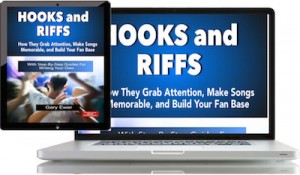 Diagnosing problems with your songwriting starts with understanding how all the separate parts of a song work together. “The Essential Secrets of Songwriting” 10-eBook bundle tells you everything you need to know, and gives you hundreds of progressions that will get your songwriting back on track. More..
Diagnosing problems with your songwriting starts with understanding how all the separate parts of a song work together. “The Essential Secrets of Songwriting” 10-eBook bundle tells you everything you need to know, and gives you hundreds of progressions that will get your songwriting back on track. More..
__________
 Hooks appear in all genres of music, including Classical (Beethoven’s famous 5th Symphony, for example). But pop songwriters talk more about the power and effectiveness of a good hook more than composers in any other genre. The reason for this is the length of the average pop tune. At 3-4 minutes, pop songs need something immediate and catchy to keep a song foremost in the listeners mind, and bring them back again.
Hooks appear in all genres of music, including Classical (Beethoven’s famous 5th Symphony, for example). But pop songwriters talk more about the power and effectiveness of a good hook more than composers in any other genre. The reason for this is the length of the average pop tune. At 3-4 minutes, pop songs need something immediate and catchy to keep a song foremost in the listeners mind, and bring them back again.
But many songs work well even in the absence of an obvious hook, if by hook we mean a short melodic/rhythmic idea that gets repeated regularly through the length of a song (and typically in a chorus). The Beatles’ “She Loves You” has a very obvious hook (“She loves you, yeah, yeah, yeah…”), but what about “Michelle“? That song succeeds more due to its use of separate melodic and rhythmic motifs that get developed and modified as the song progresses.
(And in that sense, the Beethoven 5th Symphony hook is actually more of a motif than it is a hook.)
If a song doesn’t have an obvious hook, what keeps people listening? And what keeps them returning to the song, wanting to hear it over and over again?
Generally, it’s the way the songwriter uses song form to generate musical excitement and energy. When done right, energy in a song is often not represented by a straight line, where the beginning of the song is at a low ebb, and then builds linearly to its end. Rather, it alternates between areas of low and high energy, but where the end of a song is usually more energetic than its beginning.
 “Hooks and Riffs: How They Grab Attention, Make Songs Memorable, and Build Your Fan Base” – Shows you step-by-step how to get a hook working in your own songs. With examples of great hooks from the past 6 decades of pop music.
“Hooks and Riffs: How They Grab Attention, Make Songs Memorable, and Build Your Fan Base” – Shows you step-by-step how to get a hook working in your own songs. With examples of great hooks from the past 6 decades of pop music.
It’s why so many songwriters use the verse-chorus format in their music: the areas of low and high energy are programmed into that design. Verses are typically low-energy, while choruses pump up the power.
If you find yourself worrying that your songs aren’t building a fan base like you think they should be, there can be any number of reasons. But one important area to look at is musical energy. Here are some tips to consider when diagnosing a problem that relates to song energy:
- Song energy is often subtle. There doesn’t need to be a huge difference between a low-energy section and a high-energy one. This is particularly true of ballad-style songs.
- Low energy is every bit as important as high energy. Songs that are all-powerful all the time can benefit as much by bringing quiet areas down even more, rather than always looking to pump up loud areas.
- Energy comes from more than just loudness. To make music more energetic, your instincts may tell you to play louder. But there are other important attributes to energy:
- melodic range (higher is often more energetic);
- lyrical approach (emotional lyrics generate more excitement than narrative ones);
- instrumentation (more instruments build more energy);
- rhythm (quicker instrumental rhythms, combined with longer-held notes in a vocal line, will often generate more energy).
- Make a line drawing of your song’s energy. Place a piece of paper sideways, take a pencil and start playing a recording of your song. As energy moves up, draw your line higher. As energy dissipates, move the line lower. When you’re done, you should have a fairly accurate representation of how energy moves in your song. This can be a great diagnosing tool.
And one more piece of advice: not all songs need to have dramatic highs and lows. Some songs are all about a quiet lyric that holds great meaning, not requiring hosts of instruments or power to get the point across. Only diagnose problems when you’re aware of them. If a song succeeds, don’t over-analyze why it’s working. Accept success and move on.
____________
Follow Gary on Twitter
PURCHASE and DOWNLOAD “The Essential Secrets of Songwriting” 10-eBook Bundle for your laptop/desktop, iPad, Kindle, or any other PDF-reading device. Get an 11th eBook, “Creative Chord Progressions” FREE when you make your purchase of the bundle.










Reblogged this on I Write The Music.